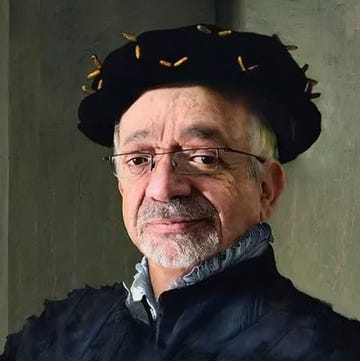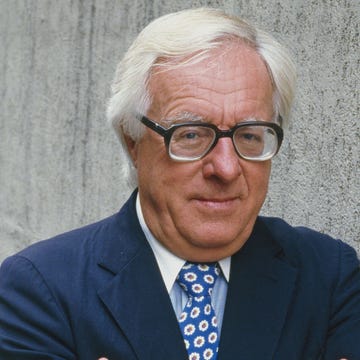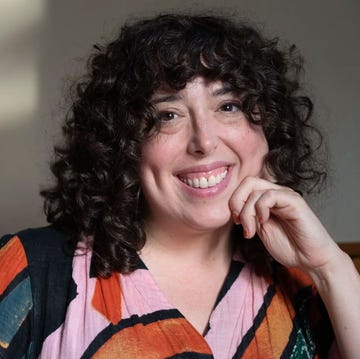Gaps and exclusions in the archive and historical record can be fruitful spaces for the imagination. Over Zoom, I ask Nishant Batsha, a historian and novelist raised in the East Bay and speaking to me from his home in Buffalo, New York, what writing his second book, the anticolonialist romance and historical novel A Bomb Placed Close to the Heart, allowed him to do that writing a history couldn’t. Noting that the archives can be frustrating, he says, “Saidiya Hartman, who pioneered the idea of critical fabulation, said that if your historical subject is not prioritized in the archive for various reasons, you’re going to have to invent the history, but that invention is grounded in historical practice.… Critical fabulation is at the core of my historical fiction writing.”
Both of Batsha’s novels are concerned with how individuals become entangled within larger political circumstances, but his sophomore novel seems especially invested in a hidden, underexplored history, engaging with critical fabulation on multiple levels. He tells me, “If there’s ever an antagonist in my books, it’s sort of the nation as such.” He identifies a quote from László Krasznahorkai’s Satantango, in which one of the characters says there is no God. Later I look it up: “There’s no sense or meaning in anything. It’s nothing but a network of dependency under enormous fluctuating pressures.” In Batsha’s own fiction, he thinks of the nation in a similar way, saying that “it is this network of interdependency amongst citizens.… At times, you don’t feel the weight of the nation at all; you just operate inside its boundaries. But then there are these moments of fracture.” He elaborates that he’s interested in how the pressure exerted by the nation “makes its way into very domestic spaces.”
A Bomb Placed Close to the Heart begins shortly before America’s entrance into World War I in 1917. The Bay Area was a heady milieu, home to various intellectuals and activists organizing around labor and social reform. Palo Alto had a strong women’s movement. And the Ghadar Party, made up of Sikh and Bengali revolutionaries who were working from afar toward India’s independence, was based in Berkeley. As Batsha’s novel begins, Indra Mukherjee, a freedom fighter, has come to California to wait for arms from Germans who have sympathy for India’s struggle to get free from British colonial rule.
Indra meets Cora, a socialist Stanford graduate student, at a party in Palo Alto. Cora grew up in a mining town in the West. Drawn into Indra’s activist circles, she advises his comrades on how to persuade the public that India’s desire for liberation from the British is righteous. As she begins writing for them, “she was dizzied by the sense of possibility. There was a capaciousness inside of her that she was only beginning to fathom. Once started, she did not want to stop.” Simultaneously, she and Indra fall in love. It’s a relationship initially filled with intense mutual admiration, yet “she had fallen for him not only because she was attracted to him, but also because she was falling for the idea, still faint but becoming more real, of becoming some new version of herself that existed only with him.”
Shortly after the couple marry, however, the United States enters World War I. California begins cracking down on Asians in California, and Indra becomes a wanted man for his connections to the enemy: Germans. He and Cora flee the state and head for New York. There, ambitions—and egos—begin to clash. Batsha draws the couple and their social circles with thought-provoking complexity.
But Batsha tells me that he began the novel with the history, not the characters. It grew out of Batsha’s own research during graduate school at Columbia University, where he earned his PhD in history while working on a dissertation about the Indian labor diaspora. He read broadly about forms of Indian migration, and one of the texts referenced Berkeley’s Ghadar Party. This organizing, he explains, “fizzled out after World War I, due to, basically, political repression of a part of the United States.” No successful agitation occurred, though the party had a newspaper that it published in Urdu and English. Indra, Batsha explains, is based on the real-life Bengali revolutionary and philosopher M.N. Roy, and Cora is based on Evelyn Trent, a white socialist writer who was Roy’s wife for a time.
“I was really drawn into that—that [Roy and Trent] met on the Stanford campus and were thrown into the powder keg of history,” Batsha muses. “Very quickly into their relationship, the Hindu-German Conspiracy Trials launched, and so they’re escaping from California, they’re marrying, they’re figuring themselves out, both politically and personally in their relationship.”
Trent was mostly lost to history—the biographical material on her is thin—which is one reason why Batsha fictionalized her as Cora. When Roy wrote his memoirs after their divorce, he made zero mention of his former wife, who went on to work at a welfare office in gold country and kept her distance from political agitation. Her own papers were destroyed in a house fire in 1962. What struck Batsha was that she wasn’t only a revolutionary’s wife: “She was an interlocutor and thinker in her own right,” he explains. “Rescuing someone from history, in a way, was extremely appealing.”
In the novel, she’s an only child whose mother died, whereas Trent had eight siblings and a mother. In developing Cora as a character, Batsha says, he may have been responding to Wallace Stegner’s Angle of Repose, thinking about “what it meant to be a singular woman, or a singular girl, being raised in the desolate West, and what kind of personality that makes.” However, Cora’s ambitions as a writer, feminist, socialist, and anticolonial thinker remain faithful to Trent. Batsha explains that, as a writer of South Asian descent who feels at times the burden of representation, he found inventing her character to be “a deeply liberating experience…because it was…a space of pure imagination.”
Batsha departs from the record for other reasons, too. For instance, in his memoirs, Roy mentions a turning point at which he started questioning the value of violence, but he doesn’t elaborate on it. “That, to me, was very profound,” Batsha says. He imagined his way into gaps in Roy’s memoir where Roy didn’t reflect on what otherwise seemed to be pivotal realizations. Similarly, in the course of his research, the novelist found that others involved had different recollections of the same events; the dissonances allowed him to “think about the evolution of a character.”
A Bomb Placed Close to the Heart explores not only the love between two people but also their love for revolutionary ideals, for the struggle. That theirs is an interracial romance occurring in the context of Asian exclusion in California figures into the novel, but Batsha didn’t want a cultural clash to be the “core wedge between them.” Believing that to be hackneyed, he looked for other, more salient conflicts and came to “the conflict of their own ambition.” Indra and Cora’s romance, he remarks, was not unique—there were several white women who married into the Indian nationalist cause at that time on the Stanford campus, such as journalist Agnes Smedley and Swiss Californian painter Frieda Hauswirth. Cultural differences didn’t factor heavily into those real-life love stories, Batsha tells me, so he didn’t want to dwell on them either.
While an understanding of history shapes the novel, what remains most memorable after the book is closed may be its metaphysical commentary, which is unhooked from specific circumstances. Batsha himself prefers to think of the book as a meditation on love and romance, like Marguerite Duras’s The Lover. He relied on French psychoanalyst Jacques Lacan’s idea that desire is a locus of lack. “You desire this other because they represent the thing that is missing from you,” Batsha explains. “But in the process of trying to build up the thing that is missing from you, you begin to grow distant from that lover.” In A Bomb Placed Close to the Heart, systemic forces bear down on two individuals who seem to have fallen in love in part because of absences in their lives—whether you believe their love can win out over the constraints that society may place on it produces the novel’s suspensefulness. It’s a timeless conflict, beautifully grappled with here.•
Anita Felicelli is Alta Journal ’s books editor and the author of How We Know Our Time Travelers, Chimerica, and Love Songs for a Lost Continent.













